身体情報力学研究グループ
グループメンバー
ミッション
研究ドメイン
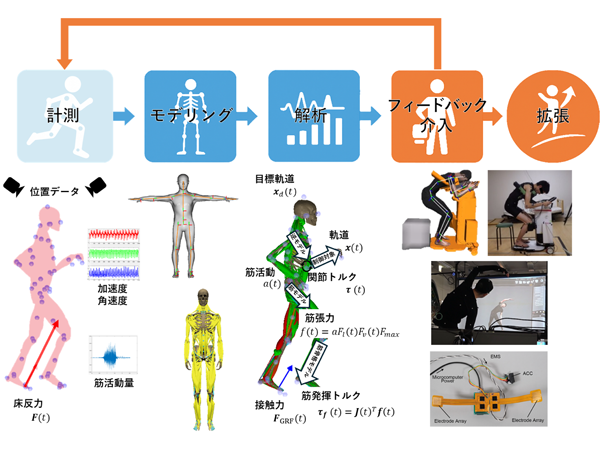
研究紹介
1.運動力学・認知インタラクションデザインによるパフォーマンスの拡張
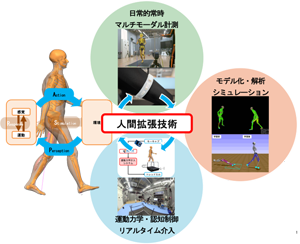
ヒトのインタラクションをデザインすることで運動・感覚能力を拡張することを目指し、①日常常時マルチモーダル計測,②モデル化・解析・シミュレーション、③運動力学・認知制御・リアルタイム介入の研究を進めます。 ①では機械学習による画像認識を用いた運動計測技術やフレキシブルセンサを用いたウェアラブルデバイスの開発、②ではバイオメカニクスによる筋骨格モデルの運動力学解析や深層学習を用いた筋骨格運動生成技術の開発、 そして③ではロボティクスによる環境の運動力学・認知制御によるリアルタイム介入に関する研究を進めます。そしてこれらをリアルタイムに回しヒトの状態を変容させることで、人間拡張を実現します。
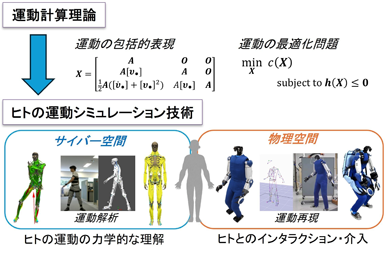
ロボティクスの基盤技術として、ヒトやロボットの運動に関する計算理論の研究を行っています。特に、ヒューマノイドロボットやデジタルヒューマンを活用し、物理世界とサイバー空間の両面からヒトの運動を再現・解析するシミュレーション技術の開発に取り組んでいます。これらを応用し、筋骨格モデルなどの精緻なヒトのモデルを用いて運動を力学的に理解するとともに、ロボットとデジタルヒューマンを融合させたインタラクション・介入技術を実現し、ヒトの能力を拡張することを目指しています。
高ロボティクスの基盤技術として、ヒトやロボットの運動に関する計算理論の研究を行っています。特に、ヒューマノイドロボットやデジタルヒューマンを活用し、物理世界とサイバー空間の両面からヒトの運動を再現・解析するシミュレーション技術の開発に取り組んでいます。これらを応用し、筋骨格モデルなどの精緻なヒトのモデルを用いて運動を力学的に理解するとともに、ロボットとデジタルヒューマンを融合させたインタラクション・介入技術を実現し、ヒトの能力を拡張することを目指しています。
(鮎澤)
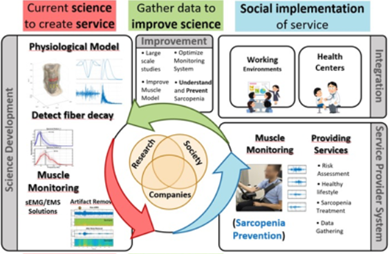
私の研究は、最先端の筋生理学と実社会での応用とのギャップを埋めることを目指しています。
高度な筋モデルやモニタリングシステムを開発し、筋線維の劣化(ファイバー・デケイ)の早期兆候を検出し、サルコペニアのような状態のメカニズムを理解することに取り組んでいます。
データ駆動型の科学を通じて、筋肉のモニタリング技術の最適化を追求し、健康的な加齢、けがの予防、リハビリテーションに貢献したいと考えています。
最終的な目標は、医療現場や職場環境、社会全体で実際に役立つソリューションを提供することです。
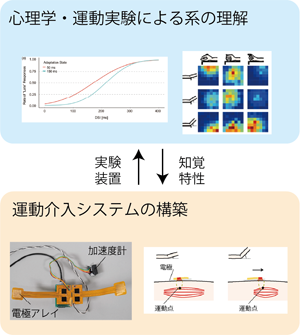
人間と機械の両者が運動意図を持ちつつも協調して一つの運動を行う人間機械統合運動に対して、身体運動の面と心理学の面からシステムを組み立てます。
また、両者を組み合わせて、運動中に外部からのアシストや運動介入があるにもかかわらずその介入を感じにくい、いわば運動介入を透明化するシステム(運動誘導システム)のアプリケーションを構築し、人間拡張システムの設計指針を提案します。
(松原)
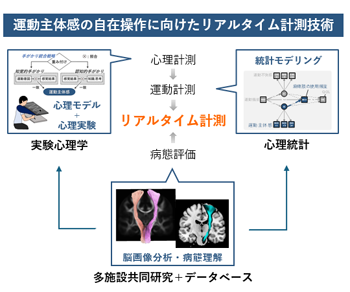
脳卒中などが招く運動障害の予防・改善に向けて、認知と運動のインタラクションに基づく行動変容システムの開発に取り組んでいます。
特に、「自分が運動を制御している」という感覚である運動主体感に着目し、臨床機関との連携を基盤に、実験心理学的手法や統計モデリングなどを駆使して、
運動主体感の定量化・モデル化・操作を軸とした認知運動インタラクションの研究を進めています。
(宮脇)
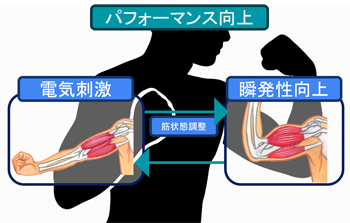
幅広い運動能力の人々が、簡単に実力差を埋めて伯仲したスポーツを楽しめれば、スポーツ参加人口の拡大に貢献すると期待されます。
そして現在、地道なトレーニングを経ずに高い運動パフォーマンスを獲得する方法として、アシストスーツや筋電気刺激が提案されています。
一方で、これらは運動を直接誘導するため、意図に反した運動を強制し、自分が運動を制御しているという感覚の喪失や転倒等の事故の危険性を伴います。
そこで、運動を直接誘導せずに運動パフォーマンスを向上させる方法として、腱への電気刺激を利用して筋肉が力を発揮しやすい状態に調整し、瞬発力を高めるアプローチについて研究しています。
(鈴木)
研究業績
- Kitagawa, M., Tanaka, T., Murai, A., & Kusaka, T. (2025).
Motion Tactics Model Combining Multiple Tactics to Represent Individual Differences in Human Running Motion.
Applied Sciences, 15(6), 3221. - Nakamae, S., Tanaka, T., Murai, A., & Kusaka, T. (2025).
Torsion as a Mechanism for Enhancing Torso Mobility by Increasing Instantaneous Torque Transfer Ratio. Journal of Robotics and Mechatronics, 37(1), 222-230. - Miyawaki, Y., Otani, T., Yamamoto, M., Morioka, S., & Murai, A. (2024).
Diminished sense of agency inhibits paretic upper-limb use in patients with post-stroke motor deficits. Cortex, 181, 165-178. - Costa-Garcia, A., Takei, Y., & Murai, A. (2024, November).
Estimating Muscle Features from Electrical Stimulation Response. In International Conference on NeuroRehabilitation (pp. 743-746). Cham: Springer Nature Switzerland. - Tanaka, T., Kawamura, T., Moromugi, S., Kurita, Y., & Murai, A. (2024).
Special Issue on Robotics and Mechatronics Technology for Sports, Exercise, and Health Care (Part 2). Journal of Robotics and Mechatronics, 36(5), 1189-1190. - Miyawaki, Y., Otani, T., Yamamoto, M., Morioka, S., & Murai, A. (2024).
Diminished sense of agency inhibits paretic upper-limb use in patients with post-stroke motor deficits. Cortex, 181, 165-178. - Cisneros-Limón, R., Dallard, A., Benallegue, M., Kaneko, K., Kaminaga, H., Gergondet, P., ...& Kheddar, A. (2024).
A cybernetic avatar system to embody human telepresence for connectivity, exploration, and skill transfer. International Journal of Social Robotics, 1-28. - Miyake, H., Ayusawa, K., Sagawa, R., & Yoshida, E. (2024, October).
Contacts from motion: Learning discrete features for automatic contact detection and estimation from human movements. In 2024 IEEE/RSJ International Conference on Intelligent Robots and Systems (IROS) (pp. 11485-11492). IEEE. - Ishigaki, T.,Ayusawa, K., & Yamamoto, K. (2024).
Comprehensive gradient computation framework of pcs model for soft robot simulation. IEEE Robotics and Automation Letters. - Wang, S., Ayusawa, K., & Yoshida, E. (2024, November).
Measuring and Analyzing Human Wide-Area Contact Motion using Tactile Sensors. In 2024 IEEE-RAS 23rd International Conference on Humanoid Robots (Humanoids) (pp. 288-294). IEEE. - Suzuki, H.,Ayusawa, K., & Murai, A. (2024).
Muscle Property Optimization Based on Motion Intentionality for Motor Skill Augmentation. Journal of Robotics and Mechatronics, 36(4), 847-855. - Sasaki, T.,Ayusawa, K., & Yoshida, E. (2024, September).
Optimizing and Predicting Human-Symbiotic Robot Trajectory. In 2024 10th IEEE RAS/EMBS International Conference for Biomedical Robotics and Biomechatronics (BioRob) (pp. 140-147). IEEE. - Shimizu, S.,Ayusawa, K., & Venture, G. (2024).
Fast Direct Optimal Control for Humanoids Based on Dynamics Representation in FPC Latent Space. IEEE Robotics and Automation Letters. - Costa-Garcia, A., & Murai, A.
The Spectral Footprint of Neural Activity: How Muap Properties and Spike Train Variability Shape Semg. Available at SSRN 5249927. - Yang, N., Ueda, S., Costa-Garcia, A.., Okajima, S., Tanabe, H. C., Li, J., & Shimoda, S. (2024).
Dynamic causal model application on hierarchical human motor control estimation in visuomotor tasks. Frontiers in Neurology, 14, 1302847. - Itkonen, M., Okajima, S., Ueda, S.,Costa-Garcia, A., Ningjia, Y., Kurogi, T., ... & Shimoda, S. (2024).
Cognitive Process during Palpation and Basic Concept of Remote Palpation System. arXiv preprint arXiv:2407.05595. - Kadi, T., Washino, S., Tsunokawa, T., Narita, K., Mankyu, H., Murai, A., & Tamaki, H. (2024).
Role of kicking action in front crawl: the inter-relationships between swimming velocity, hand propulsive force and trunk inclination. Sports Biomechanics, 1-19. - Narita, K., Washino, S., Kadi, T., Kanehisa, H., Mankyu, H., & Fujita, E. (2025).
Does body composition relate to active drag during arms-only front crawl swimming in male collegiate swimmers?. Journal of Science and Medicine in Sport. - Washino, S., Murai, A. , Kadi, T., Mankyu, H., & Yoshitake, Y. (2025).
Stroke phase differences in the linear relationship between swimming velocity and vertical body position during front crawl. Sports Biomechanics, 1-14. - Washino, S., Murai, A., Kadi, T., Narita, K., Mankyu, H., & Yoshitake, Y. (2025).
Interpreting the Projected Frontal Area in Front Crawl: Determining the Projected Frontal Area of Each Body Segment. Medicine and science in sports and exercise, 57(2), 390-399.
- 2025.5 [領域論文賞]:宮脇裕, 大谷武史, 山本雅樹, 森岡周, 村井昭彦
“Diminished sense of agency inhibits paretic upper-limb use in patients with post-stroke motor deficits“, 国立研究開発法人産業技術総合研究所. - 2024.9 [最優秀賞]:宮脇裕, 大谷武史, 山本雅樹, 森岡周, 村井昭彦
“運動主体感の減少が脳卒中後の上肢使用量にもたらす影響とは?“, 第22回日本神経理学療法学会学術大会. - 2024.10 [優秀賞]: 加地智哉, 鷲野壮平, 鮎澤光, 工藤重忠, 成田健造, 萬久博敏, 村井昭彦
“クロール泳の足部にはたらく鉛直・進行方向における力と泳速度との関係“, 日本水泳・水中運動学会








